Frequency and theoretical correlates of television binge-watching
VerifiedAdded on 2023/01/19
|5
|1242
|95
AI Summary
This article analyzes the frequency and theoretical correlates of television binge-watching, exploring its effects and modifiable behaviors. Published in the Journal of Health Psychology in 2018.
Contribute Materials
Your contribution can guide someone’s learning journey. Share your
documents today.
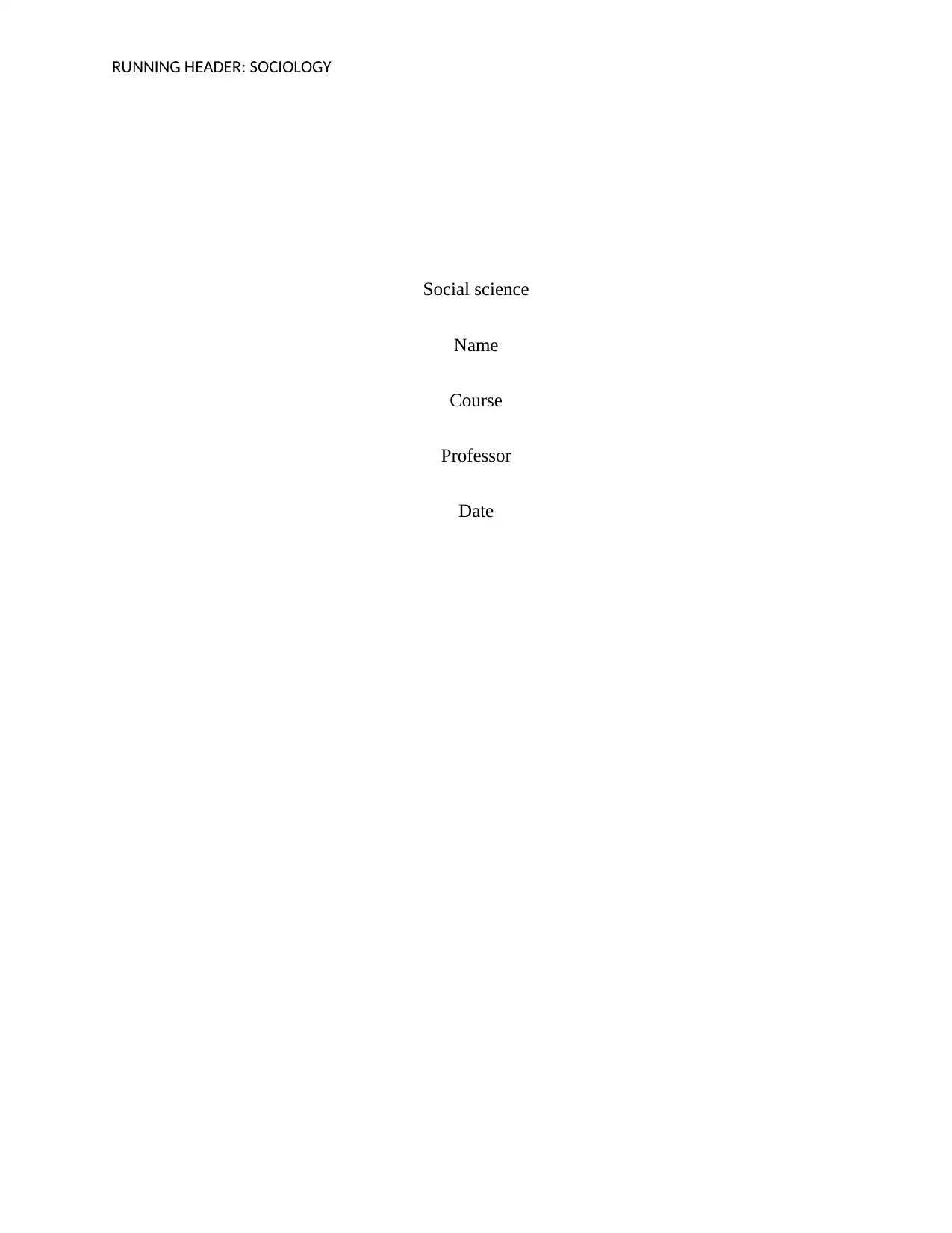
RUNNING HEADER: SOCIOLOGY
Social science
Name
Course
Professor
Date
Social science
Name
Course
Professor
Date
Secure Best Marks with AI Grader
Need help grading? Try our AI Grader for instant feedback on your assignments.
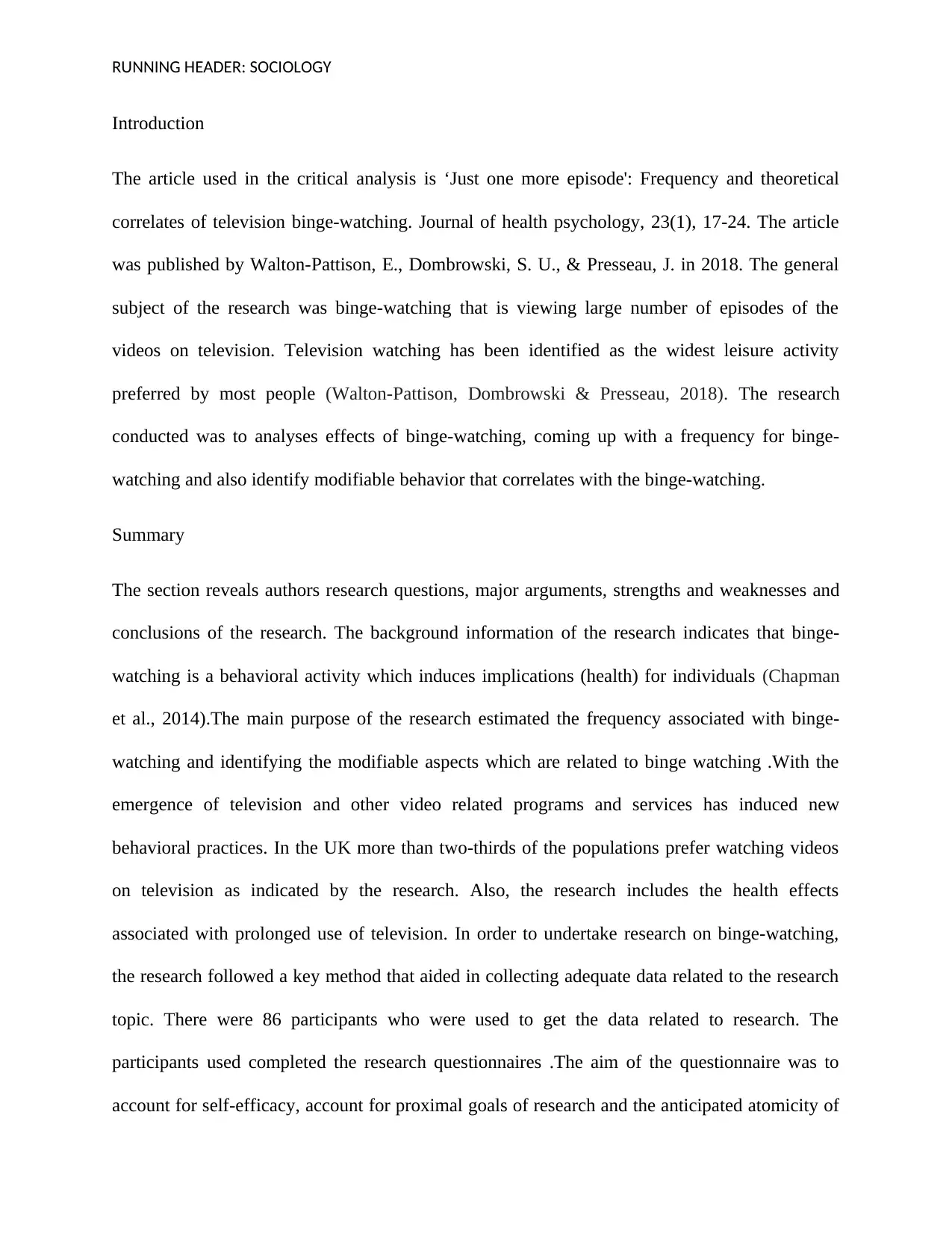
RUNNING HEADER: SOCIOLOGY
Introduction
The article used in the critical analysis is ‘Just one more episode': Frequency and theoretical
correlates of television binge-watching. Journal of health psychology, 23(1), 17-24. The article
was published by Walton-Pattison, E., Dombrowski, S. U., & Presseau, J. in 2018. The general
subject of the research was binge-watching that is viewing large number of episodes of the
videos on television. Television watching has been identified as the widest leisure activity
preferred by most people (Walton-Pattison, Dombrowski & Presseau, 2018). The research
conducted was to analyses effects of binge-watching, coming up with a frequency for binge-
watching and also identify modifiable behavior that correlates with the binge-watching.
Summary
The section reveals authors research questions, major arguments, strengths and weaknesses and
conclusions of the research. The background information of the research indicates that binge-
watching is a behavioral activity which induces implications (health) for individuals (Chapman
et al., 2014).The main purpose of the research estimated the frequency associated with binge-
watching and identifying the modifiable aspects which are related to binge watching .With the
emergence of television and other video related programs and services has induced new
behavioral practices. In the UK more than two-thirds of the populations prefer watching videos
on television as indicated by the research. Also, the research includes the health effects
associated with prolonged use of television. In order to undertake research on binge-watching,
the research followed a key method that aided in collecting adequate data related to the research
topic. There were 86 participants who were used to get the data related to research. The
participants used completed the research questionnaires .The aim of the questionnaire was to
account for self-efficacy, account for proximal goals of research and the anticipated atomicity of
Introduction
The article used in the critical analysis is ‘Just one more episode': Frequency and theoretical
correlates of television binge-watching. Journal of health psychology, 23(1), 17-24. The article
was published by Walton-Pattison, E., Dombrowski, S. U., & Presseau, J. in 2018. The general
subject of the research was binge-watching that is viewing large number of episodes of the
videos on television. Television watching has been identified as the widest leisure activity
preferred by most people (Walton-Pattison, Dombrowski & Presseau, 2018). The research
conducted was to analyses effects of binge-watching, coming up with a frequency for binge-
watching and also identify modifiable behavior that correlates with the binge-watching.
Summary
The section reveals authors research questions, major arguments, strengths and weaknesses and
conclusions of the research. The background information of the research indicates that binge-
watching is a behavioral activity which induces implications (health) for individuals (Chapman
et al., 2014).The main purpose of the research estimated the frequency associated with binge-
watching and identifying the modifiable aspects which are related to binge watching .With the
emergence of television and other video related programs and services has induced new
behavioral practices. In the UK more than two-thirds of the populations prefer watching videos
on television as indicated by the research. Also, the research includes the health effects
associated with prolonged use of television. In order to undertake research on binge-watching,
the research followed a key method that aided in collecting adequate data related to the research
topic. There were 86 participants who were used to get the data related to research. The
participants used completed the research questionnaires .The aim of the questionnaire was to
account for self-efficacy, account for proximal goals of research and the anticipated atomicity of
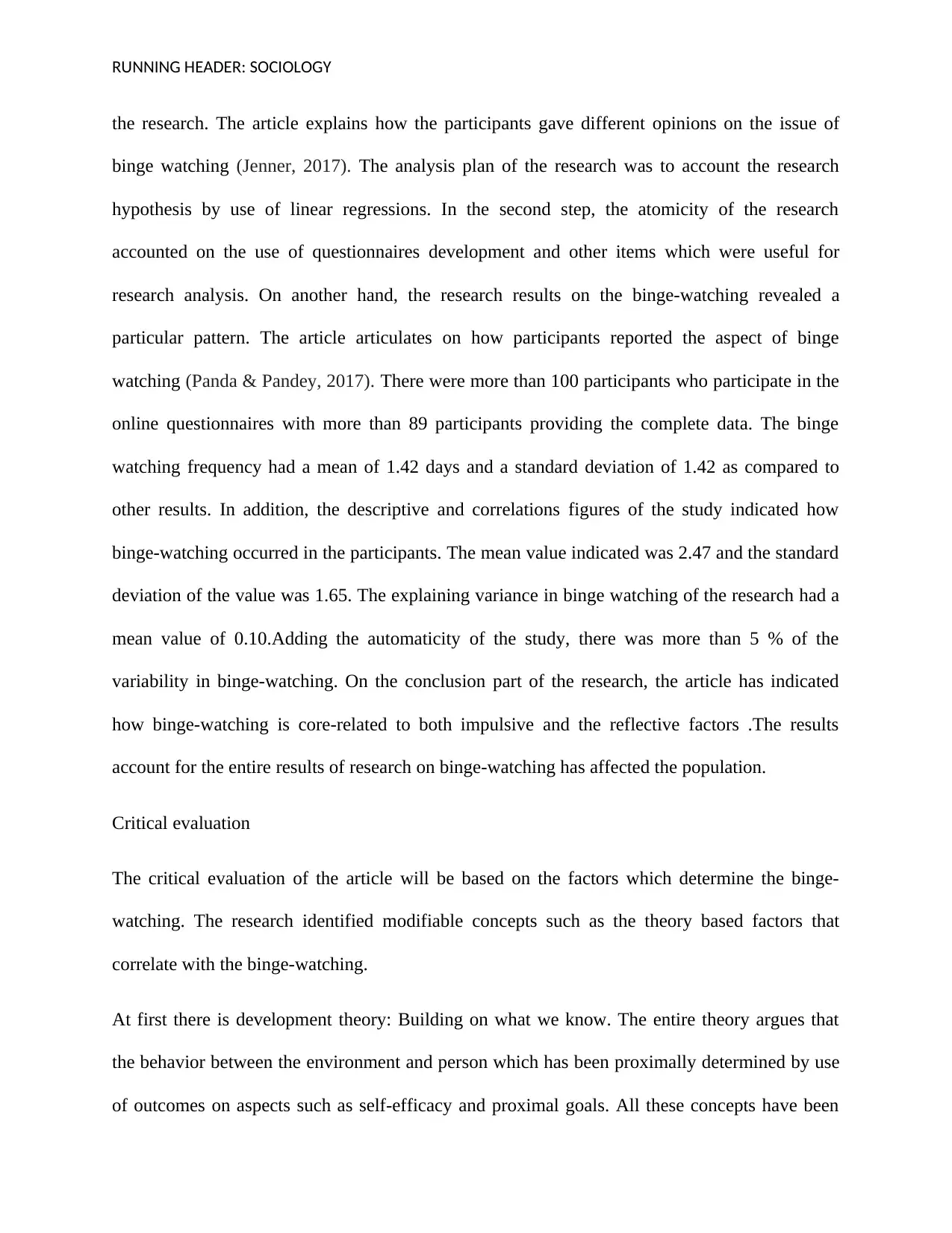
RUNNING HEADER: SOCIOLOGY
the research. The article explains how the participants gave different opinions on the issue of
binge watching (Jenner, 2017). The analysis plan of the research was to account the research
hypothesis by use of linear regressions. In the second step, the atomicity of the research
accounted on the use of questionnaires development and other items which were useful for
research analysis. On another hand, the research results on the binge-watching revealed a
particular pattern. The article articulates on how participants reported the aspect of binge
watching (Panda & Pandey, 2017). There were more than 100 participants who participate in the
online questionnaires with more than 89 participants providing the complete data. The binge
watching frequency had a mean of 1.42 days and a standard deviation of 1.42 as compared to
other results. In addition, the descriptive and correlations figures of the study indicated how
binge-watching occurred in the participants. The mean value indicated was 2.47 and the standard
deviation of the value was 1.65. The explaining variance in binge watching of the research had a
mean value of 0.10.Adding the automaticity of the study, there was more than 5 % of the
variability in binge-watching. On the conclusion part of the research, the article has indicated
how binge-watching is core-related to both impulsive and the reflective factors .The results
account for the entire results of research on binge-watching has affected the population.
Critical evaluation
The critical evaluation of the article will be based on the factors which determine the binge-
watching. The research identified modifiable concepts such as the theory based factors that
correlate with the binge-watching.
At first there is development theory: Building on what we know. The entire theory argues that
the behavior between the environment and person which has been proximally determined by use
of outcomes on aspects such as self-efficacy and proximal goals. All these concepts have been
the research. The article explains how the participants gave different opinions on the issue of
binge watching (Jenner, 2017). The analysis plan of the research was to account the research
hypothesis by use of linear regressions. In the second step, the atomicity of the research
accounted on the use of questionnaires development and other items which were useful for
research analysis. On another hand, the research results on the binge-watching revealed a
particular pattern. The article articulates on how participants reported the aspect of binge
watching (Panda & Pandey, 2017). There were more than 100 participants who participate in the
online questionnaires with more than 89 participants providing the complete data. The binge
watching frequency had a mean of 1.42 days and a standard deviation of 1.42 as compared to
other results. In addition, the descriptive and correlations figures of the study indicated how
binge-watching occurred in the participants. The mean value indicated was 2.47 and the standard
deviation of the value was 1.65. The explaining variance in binge watching of the research had a
mean value of 0.10.Adding the automaticity of the study, there was more than 5 % of the
variability in binge-watching. On the conclusion part of the research, the article has indicated
how binge-watching is core-related to both impulsive and the reflective factors .The results
account for the entire results of research on binge-watching has affected the population.
Critical evaluation
The critical evaluation of the article will be based on the factors which determine the binge-
watching. The research identified modifiable concepts such as the theory based factors that
correlate with the binge-watching.
At first there is development theory: Building on what we know. The entire theory argues that
the behavior between the environment and person which has been proximally determined by use
of outcomes on aspects such as self-efficacy and proximal goals. All these concepts have been
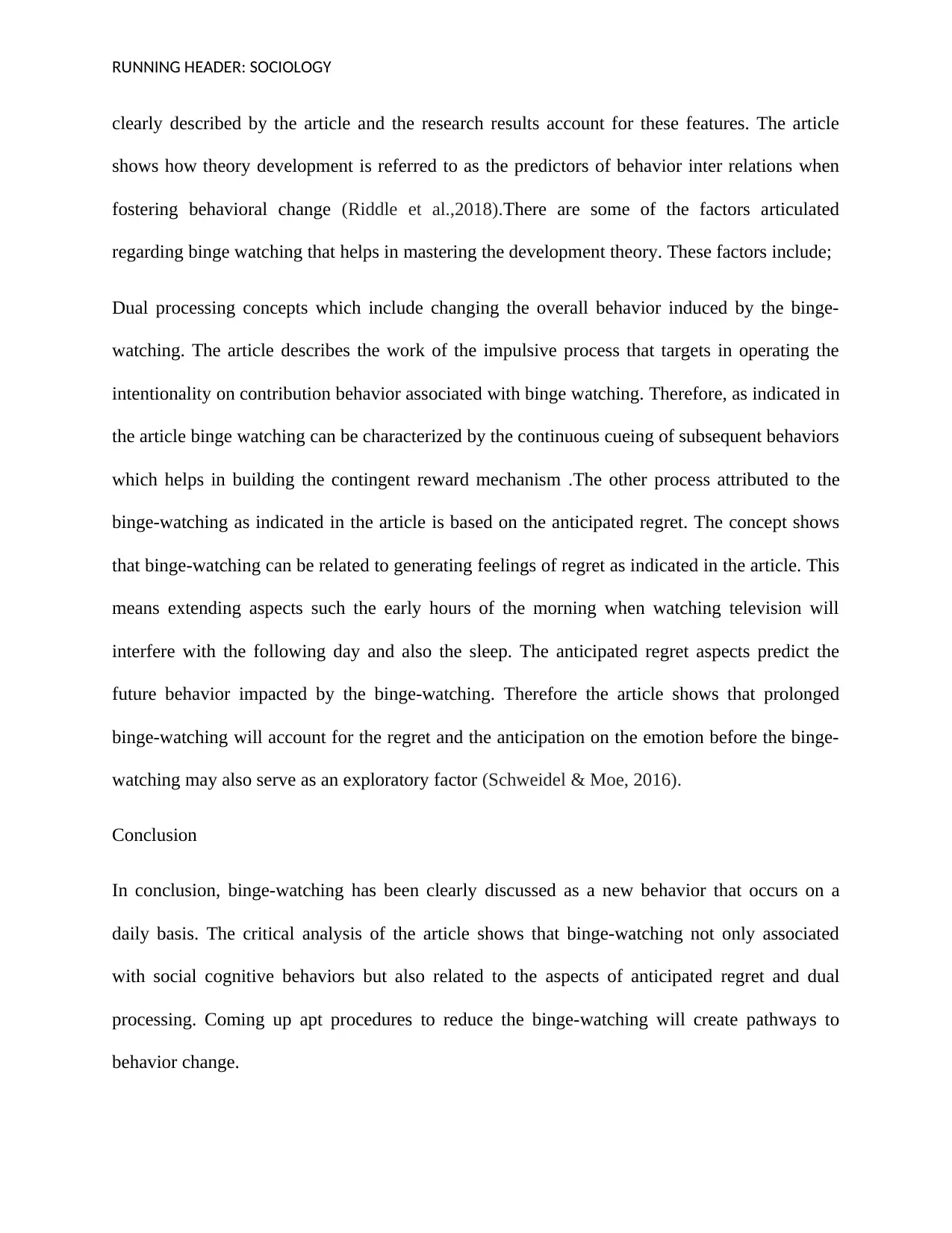
RUNNING HEADER: SOCIOLOGY
clearly described by the article and the research results account for these features. The article
shows how theory development is referred to as the predictors of behavior inter relations when
fostering behavioral change (Riddle et al.,2018).There are some of the factors articulated
regarding binge watching that helps in mastering the development theory. These factors include;
Dual processing concepts which include changing the overall behavior induced by the binge-
watching. The article describes the work of the impulsive process that targets in operating the
intentionality on contribution behavior associated with binge watching. Therefore, as indicated in
the article binge watching can be characterized by the continuous cueing of subsequent behaviors
which helps in building the contingent reward mechanism .The other process attributed to the
binge-watching as indicated in the article is based on the anticipated regret. The concept shows
that binge-watching can be related to generating feelings of regret as indicated in the article. This
means extending aspects such the early hours of the morning when watching television will
interfere with the following day and also the sleep. The anticipated regret aspects predict the
future behavior impacted by the binge-watching. Therefore the article shows that prolonged
binge-watching will account for the regret and the anticipation on the emotion before the binge-
watching may also serve as an exploratory factor (Schweidel & Moe, 2016).
Conclusion
In conclusion, binge-watching has been clearly discussed as a new behavior that occurs on a
daily basis. The critical analysis of the article shows that binge-watching not only associated
with social cognitive behaviors but also related to the aspects of anticipated regret and dual
processing. Coming up apt procedures to reduce the binge-watching will create pathways to
behavior change.
clearly described by the article and the research results account for these features. The article
shows how theory development is referred to as the predictors of behavior inter relations when
fostering behavioral change (Riddle et al.,2018).There are some of the factors articulated
regarding binge watching that helps in mastering the development theory. These factors include;
Dual processing concepts which include changing the overall behavior induced by the binge-
watching. The article describes the work of the impulsive process that targets in operating the
intentionality on contribution behavior associated with binge watching. Therefore, as indicated in
the article binge watching can be characterized by the continuous cueing of subsequent behaviors
which helps in building the contingent reward mechanism .The other process attributed to the
binge-watching as indicated in the article is based on the anticipated regret. The concept shows
that binge-watching can be related to generating feelings of regret as indicated in the article. This
means extending aspects such the early hours of the morning when watching television will
interfere with the following day and also the sleep. The anticipated regret aspects predict the
future behavior impacted by the binge-watching. Therefore the article shows that prolonged
binge-watching will account for the regret and the anticipation on the emotion before the binge-
watching may also serve as an exploratory factor (Schweidel & Moe, 2016).
Conclusion
In conclusion, binge-watching has been clearly discussed as a new behavior that occurs on a
daily basis. The critical analysis of the article shows that binge-watching not only associated
with social cognitive behaviors but also related to the aspects of anticipated regret and dual
processing. Coming up apt procedures to reduce the binge-watching will create pathways to
behavior change.
Secure Best Marks with AI Grader
Need help grading? Try our AI Grader for instant feedback on your assignments.
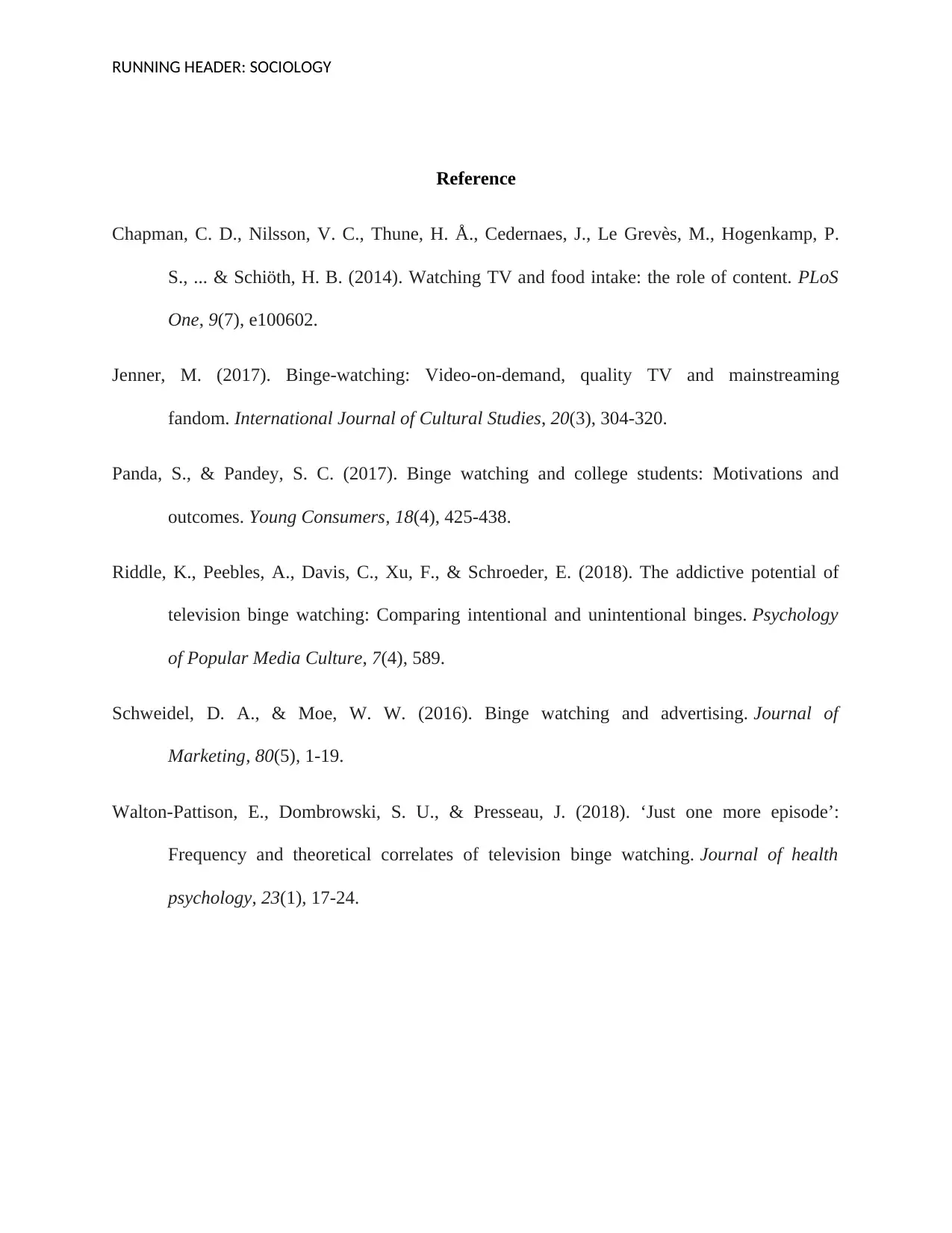
RUNNING HEADER: SOCIOLOGY
Reference
Chapman, C. D., Nilsson, V. C., Thune, H. Å., Cedernaes, J., Le Grevès, M., Hogenkamp, P.
S., ... & Schiöth, H. B. (2014). Watching TV and food intake: the role of content. PLoS
One, 9(7), e100602.
Jenner, M. (2017). Binge-watching: Video-on-demand, quality TV and mainstreaming
fandom. International Journal of Cultural Studies, 20(3), 304-320.
Panda, S., & Pandey, S. C. (2017). Binge watching and college students: Motivations and
outcomes. Young Consumers, 18(4), 425-438.
Riddle, K., Peebles, A., Davis, C., Xu, F., & Schroeder, E. (2018). The addictive potential of
television binge watching: Comparing intentional and unintentional binges. Psychology
of Popular Media Culture, 7(4), 589.
Schweidel, D. A., & Moe, W. W. (2016). Binge watching and advertising. Journal of
Marketing, 80(5), 1-19.
Walton-Pattison, E., Dombrowski, S. U., & Presseau, J. (2018). ‘Just one more episode’:
Frequency and theoretical correlates of television binge watching. Journal of health
psychology, 23(1), 17-24.
Reference
Chapman, C. D., Nilsson, V. C., Thune, H. Å., Cedernaes, J., Le Grevès, M., Hogenkamp, P.
S., ... & Schiöth, H. B. (2014). Watching TV and food intake: the role of content. PLoS
One, 9(7), e100602.
Jenner, M. (2017). Binge-watching: Video-on-demand, quality TV and mainstreaming
fandom. International Journal of Cultural Studies, 20(3), 304-320.
Panda, S., & Pandey, S. C. (2017). Binge watching and college students: Motivations and
outcomes. Young Consumers, 18(4), 425-438.
Riddle, K., Peebles, A., Davis, C., Xu, F., & Schroeder, E. (2018). The addictive potential of
television binge watching: Comparing intentional and unintentional binges. Psychology
of Popular Media Culture, 7(4), 589.
Schweidel, D. A., & Moe, W. W. (2016). Binge watching and advertising. Journal of
Marketing, 80(5), 1-19.
Walton-Pattison, E., Dombrowski, S. U., & Presseau, J. (2018). ‘Just one more episode’:
Frequency and theoretical correlates of television binge watching. Journal of health
psychology, 23(1), 17-24.
1 out of 5
Your All-in-One AI-Powered Toolkit for Academic Success.
+13062052269
info@desklib.com
Available 24*7 on WhatsApp / Email
![[object Object]](/_next/static/media/star-bottom.7253800d.svg)
Unlock your academic potential
© 2024 | Zucol Services PVT LTD | All rights reserved.
